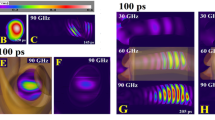Abstract
The assessment of the exposure to electromagnetic waves is nowadays a key question. Dealing with the relationship between exposure and incident field, most of previous investigations have been performed with a single plane wave. Realistic exposure in the far field can be modeled as multiple plane waves with random direction of arrival, random amplitude, and random phase. This paper, based on numerical investigations, studies the whole body specific absorption rate (SAR) linked to the exposure induced by five random plane waves having uniformly distributed angles of arrival in the horizontal plane, log-normal distributed amplitudes, and uniformly distributed phases. A first result shows that this random heterogeneous exposure generates maximal variations of ±25% for the whole body specific absorption. An important observation is that the exposure to a single plane wave arriving face to the body, used for the guidelines, does not constitute the worst case. We propose a surrogate model to assess the distribution of the whole body SAR in the case of an exposure to multiple plane waves. For a sample of 30 values of whole body SAR induced by five plane waves at 2.4 GHz, this simple approach, considering the resulting SAR as the sum of the SAR induced by each isolated plane wave, leads to an estimated distribution of whole body SAR following the real distribution with a p value of 76% according to the Kolmogorov statistical test.













Similar content being viewed by others
References
ICNIRP (1998) Guidelines for limiting exposure to time varying electric magnetic and electromagnetic field (up to 300 GHz). Radiat Prot Health Phys 74:494–522
Gandhi OP, Lazzi G, Furse C (1996) Electromagnetic absorption in the human head and neck for mobile telephones at 835 MHz and 1900 MHz. IEEE Trans Microwave Theory Tech 44:1884–1897
Conil E, Hadjem A, Lacroux F, Wong MF, Wiart J (2008) Variability analysis of SAR from 20 MHz to 2.4 GHz for different adult and child models using FDTD. Phys Med Biol 53:1511–1525
Hadjem A, Lautru D, Dale CM, Wong F, Hanna VF, Wiart J (2005) Study of Specific Absorption Rate (SAR) induced in the two child head models and adult heads using a mobile phones. IEEE Trans Microwave Theory Tech 53(1):4–11
Dimbylow PJ (1996) The development of realistic voxel phantoms for electromagnetic field dosimetry Proc Int. Workshop on Voxel Phantom Development (National Radiological Protection Board Report) pp 1–7
Dimbylow P, Bolch W (2007) Whole-body-averaged SAR from 50 MHz to 4 GHz in the University of Florida child voxel phantoms. Phys Med Biol 52:6639–6649
Neubauer G, Cecil S, Preiner P, Mitrevski N, Vermeeren G, Wout J, Martens L, Kuehn S, Kuster N (2006) The relation between SAR and the electromagnetic field distribution for heterogeneous exposure conditions, EUCAP, The First European Conference on Antennas and Propagation, 6–10 November 2006, Nice, Proceeding CD
Georg Neubauer et al. The relation between the specific absorption rate and electromagnetic field intensity for heterogeneous exposure conditions at mobile communications frequencies. Bioelectromagnetics 30(8):651–662
Kuehn S, Jennings W, Christ A, Kuster N (2009) Assessment of induced radio-frequency electromagnetic fields in various anatomical human body models. Phys Med Biol 54:875–890
Vermeeren G, Joseph W, Olivier C, Martens L (2008) Statistical multipath exposure of a human in a realistic electromagnetic environment. Health Phys 94(4):345–354
Kalliola K, Sulonen K, Laitinen H, Kiveks O, Krogerus J, Vainikainen P (2002) Angular power distribution and mean effective gain of mobile antenna in different propagation environments. IEEE Trans Veh Technol 51:823–838
El Habachi A, Conil E, Hadjem A, Vazquez E, Wong MF, Gati A, Wiart J (2010) Statistical analysis of whole-body absorption depending on anatomical human characteristics at a frequency of 2.1 GHz. Phys Med Biol 55(1):1875–1887
Christ A, Kainz W, Hahn E, Honegger K, Shen J, Rascher W, Janka R, Bautz W, Kiefer B, Schmitt P, Hollenbach H, Chen J, Kam A, Neufeld E, Oberle M, Kuster N (2007) The virtual family project-development of anatomical whole-body models of two adults and two children. Proceedings of the 23rd Annual Review of Progress in Applied Computational Electromagnetics (ACES)
Wang J, Fujiwara O, Watanabe S (2006) Approximation of aging effect on dielectric tissue properties for SAR assessment of mobile telephones. IEEE Trans Electromagn Compat 48(2):408–413
Gabriel C et al. (1996) Compilation of the dielectric properties of body tissues at RF and microwave frequencies. Brooks Air Force Technical Report AL/OE TE (1996–0037)
Zhao X, Kivinen J, Vainikainen P, Skog K (2002) Propagation characteristics for wideband outdoor mobile communications at 5.3 GHz. IEEE J Sel Areas Commun 20:507–514
Taflove A, Hagness S (2005) Computational electrodynamics: the finite-difference time-domain method, 3rd edn. Artech House Publish, Norwood, MA
Berenger J (1994) A perfectly matcher layer for the absorption of electromagnetic waves. J Comp Physiol 114:185–200
Merewether DE, Fisher R, Smith FW (1980) On implementing a numeric Huygen’s source scheme in a finite difference program to illuminate scattering bodies. IEEE Trans Nucl Sci 27:1829–1833
Shorack GR, Wellner JA (1986) Empirical processes with applications to statistics. Wiley, New York, p 976
Lee WC-Y, Brandt RH (1973) The elevation angle of mobile radio signal arrival. IEEE Trans Commun COM-21(11):1194–1197
Conil E, Hadjem A, Gati A, Wong M-F, Wiart J (2011) Influence of plane-wave incidence angle on whole body and local exposure at 2100 MHz. IEEE Trans Electromagn Compat 53(1):48–52
Gerald CF, Wheatley PO (1994) Applied Numerical Analysis, 5th ed. Reading, MA: Addison-Wesley, ch. 10, pp 696–748
Acknowledgment
This work was sponsored by the Agence Nationale de la Recherche in the framework of the Mutlipass project (whist.institut-telecom.fr).
Author information
Authors and Affiliations
Corresponding author
Rights and permissions
About this article
Cite this article
Kientega, T., Conil, E., Hadjem, A. et al. A surrogate model to assess the whole body SAR induced by multiple plane waves at 2.4 GHz. Ann. Telecommun. 66, 419–428 (2011). https://doi.org/10.1007/s12243-011-0261-z
Received:
Accepted:
Published:
Issue Date:
DOI: https://doi.org/10.1007/s12243-011-0261-z




